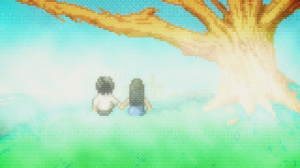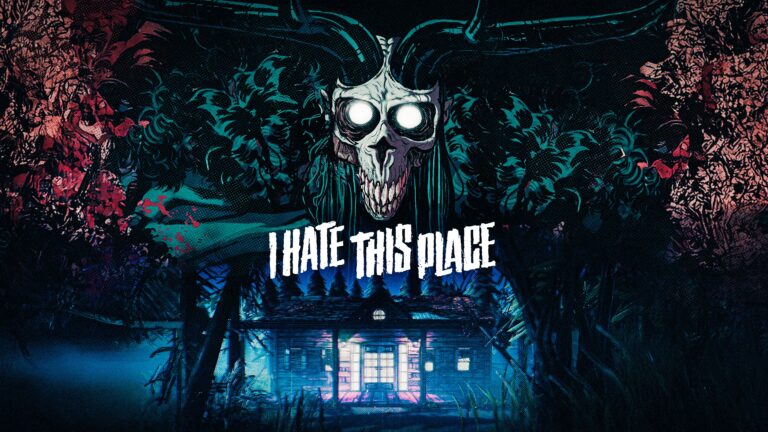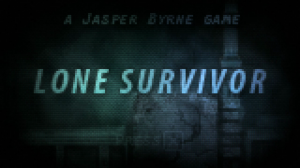
Every once in a while, a video game comes forth that both shatters expectations and lays out a foundation for a new type of game to follow suit with. These games stand out not only because they are excellent stand-alone titles, but are impacting with their creative vision and execution. They go out to try and accomplish something, and challenge what gamers and developers alike have come to accept about a genre or style of game. Lone Survivor is both one of these titles, and not. It is both one of the single most surprising horror games I have had the pleasure to experience in quite some time, and one of the most disappointing.
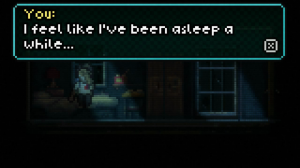
Lone Survivor is a 2D indie psychological horror game created by Jasper Byrne at Superflat Games. Probably best known for the Adult Swim game, Soul Brother, and his demake of Silent Hill 2, Soundless Mountain II, he has worked on this game for the last four years, which has almost been entirely developed by him, from the graphics, music, writing, and programming for the title.
The game follows a nameless boy donning a surgical mask who may just be the last survivor on the planet. An outbreak of disease has spread like wildfire, and our nameless protagonist has to get by day-by-day and venture out further and further just to survive. However, his mental state seems to be suffering as it gets harder and harder to tell what is real and what’s figments of his imagination. What might sound like a fairly basic set-up actually leads into quite an interesting psychological horror story. You constantly are unsure of the exact danger you’re in, questioning both the world around you and your own character. Appropriately like the game around it, the story will start to feel like it’s clicking together when some strange new element comes in and twists it all up. The story is well-done, but at the time of review I did notice a few typos during a few segments of the game. These likely will be fixed in the future via updates, but it’s something to note here at release. I also did feel that towards the game’s final act things start to feel a bit rushed, as everything else prior seemed so excellently paced. When I first completed the game I was initially left with more questions than answers, but I did figure more of it out through subsequent playthroughs and alternate endings. The game has quite the thought-provoking psychological horror story with some well-placed off-beat humor and, surprisingly, well-done touching moments that may shake you up emotionally more than you’d expect.
The game hosts some fantastic audio design. Even though the game is two-dimensional, there are a ton of excellent audio effects; from hearing something echoing from the distance in a dark hallway, to hearing a strange noise gurgling from behind the wall you’re passing. Unsettling noises exist all around, with fantastic ambiance balanced out with unnerving silence to fit the mood when it’s appropriate. The game also hosts an amazing soundtrack that really shows what Jasper Byrne can accomplish with his 13-years of musical experience. The soundtrack goes into all sorts of styles, ranging from very unsettling pieces of tense music, to nice and smooth jazz strings that resonate with an almost Twin Peaks vibe. The music stands out the most during the game’s emotional scenes, and helps in a big way to express and convey the mood. Simply put, it captures both the mood of the game perfectly and stands on its own as a great soundtrack to listen to by itself.
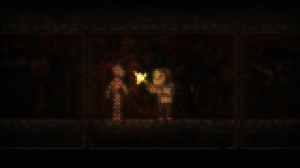
One of the most controversial elements for the game no matter how you look at it is, funnily enough, how it looks. The graphics are done with very few pixels, making the game look like something between an 8-bit and a 16-bit game, or a mosaic style. Between the graphical style and its two-dimensional foundation, some will likely be turned off initially by the game’s design decisions. A resounding question I had in the back of my head going in was if the game could really work as a horror game? There are a very small number of 2D horror games out there, and even less that could be considered remotely atmospheric or scary by even the tamest standards. Through the first 30 or so minutes of the game, I wasn’t sold that this small-detail spriting format could work to make an engrossing atmosphere or experience. However, as everything started to settle in and the game started picking up, my opinion did a complete 180°.
The graphics are detailed enough to actually be quite beautiful, but simple enough that it never fully details anything. A perfect blend that really captures the players imagination such as old PSX horror games like Silent Hill or Resident Evil have in the past. I found that while playing my mind filled in the spots of details, and even now I find myself reflecting on the twisted images I conjured up for the monsters and environments during my playtime. Its been a long time since any horror game has had that effect on me, and a reminder what a powerful tool our own minds are for the genre. The lighting is extremely impressive for a 2D game and is appropriately oppressive, moody, and unsettling. I found myself enthralled with each interesting location I visited, laid out with a lot of small effects that really bring the locales alive.
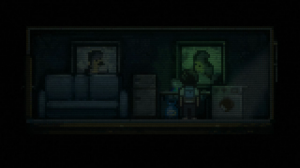
But how does the game’s 2D nature hold up with the concept? The game is best described as a side-scrolling adventure game. However, what I really got strong vibes of throughout was the early Resident Evil and Silent Hill games. In the game you explore environments while being able to move left or right. The mechanics are based around what items and gear you obtain, and interacting with your surroundings. Your choices also affect the game more substantially than I’ve seen in most games. Offense, defense, what you consume, what you do, how you respond to inquiries, and how well you take care of yourself all play part in how the game rolls out for you.
Your form of offense is through firearms, or more specifically a handgun, which works almost like a 2D form of the Resident Evil Revelations gunplay. You pull out your gun and can slowly pace back and forth (though the gun can only stay pointed in one direction, you’ll have to put it down and pull it out while facing the other direction to protect your rear) and aim it upward or downward. Enemies are composed of three sections: the head, torso, and legs. Shooting these different spots have different effects on different enemies, making experimentation key. One example is the most basic of enemies gets damaged most when shooting it in the head, which you can only shoot when aiming upward when the enemy is close to you, but that also gives the monster a window to attack you first. Shooting its legs makes it stagger back in a daze a bit so it won’t be able to attack for a few moments. This sounds like a good idea initially, but shooting the legs will sometimes make the enemy opt to jump and crawl on the ceilings to try and get a sneak attack from above.
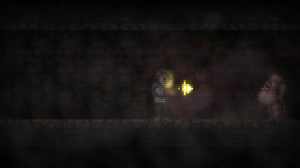
Ammo is scarce though, and it is often better to try and sneak past your foes. Through the use of flares, laying out rotting meat to get the beasts attention, or by sneaking past them via crevices in the walls, you can get past enemies without killing them. While this takes more time and crafty maneuvering, it can help save health and ammo for when you really need it, as well as make you like what you see when you look in the mirror. I should explain.
The game changes based on your actions. Besides being a gameplay style choice, killing a bunch of enemies does change your character and story path substantially. The same goes for whenever you sleep and eat properly, if you decide to pop pills for their benefits, how you answer questions, if you help someone out or not, or take the time to complete a side-quest. These lead to different outcomes that can take your story and ending in a different direction. You have to think about how you kill, use your items, and how you take care of yourself wisely. The way to measure your status isn’t through bars or statistics, but rather what your character says. As he gets hungry, he’ll start talking to himself about how hungry he is. When tired, how tired he is. If he’s starting to feel addicted to pills, he’ll comment. It’s through his comments you can gauge how your character is currently standing, both in physical and mental health.
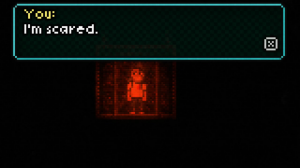
So what did I think of the game? Well first of all, this is probably the scariest 2D game I’ve ever played. But don’t go in expecting Amnesia: The Dark Descent level scares. There’s a few really cool scares and tense moments, but I found them more on par with the days of static-camera horror games, which is quite an achievement for a 2D game. That’s a feeling that resonated a lot with me through this game. A lot of what it does has been done similarly in those static-camera angle horror games, but it feels fresh here both because of its two-dimensional nature and simply because old-school horror games have been on break for so long. Some of the clunky controls from horror games back in the day come in play here as well, but I never found them annoying and I wouldn’t really want them any other way. It adds to this title’s charm and ‘old-school horror demake’ sort of feel.
The game has an excellent and well-paced stride that goes for it during the first 3-4 hours of play that really stood out to me as quality horror entertainment. And this feeling could of continued if the game suddenly didn’t come to a stop. This is my single biggest problem with the game, and the reason I have some mixed feelings about it. The game starts off a bit rough around the edges, but really opens up after the first 20-30 minutes. The game is in it’s stride at this point, it has the makings of a great horror game and builds up so many interesting elements and characters, atmosphere, good gameplay variety. You overcome these fantastic set-pieces and it builds your excitement, you want to keep on going. You enter an area that really seems to open the game up… Only to find the game is actually entering its closure. The game just ends too abruptly; there were elements here that felt like they could last a game twice or three times as long. Imagine Silent Hill 1, except the game ends right when you reach the hospital. Or Resident Evil, but the game ends right when you get outside of the mansion. It’s opening chapter is great, it really pulls you in… Only for you to find out that wasn’t the game’s first third or half, that was actually the game. Maybe in the future the game will be expanded. Jasper has expressed he would like to add more content to the game over time, and buying the game signs you up for free DRM updates for the rest of the game’s life. However, as it is now, the game is over when it feels like it’s only just started.
For my complaints about the length and sudden ending though, the game does actually have a pretty good level of replayability, with side quests, alternate endings, and the game changing based on how you play. On my first playthrough I clocked in almost five hours before completion, though part of that was doing a side-quest and one point I got a bit stuck at.
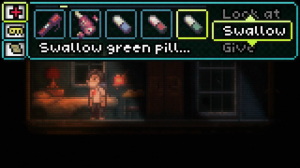
This game is inspiring. I hope it sends out the message to other indie developers that a 2D horror game can work. While the game lasts, it is intriguing, tense, and almost novel at its subtlety. The game doesn’t rely on cheap scares or an action-focus, instead presenting itself with a fantastic subtle and unnerving lonely atmosphere and a choose-how-you-play gameplay style that is done even better than most ‘professional’ games can muster. The characters are quirky and interesting, the locales are as enchanting as they are morbid, and it’s all fitted together by a game that feels both like an old-school horror game and yet something new and fresh. Unfortunately it ends when things are really taking off, and I found myself wanting more by the time I was through. Whenever you read into that as telling of how good the game is or of how disappointingly abrupt its ending may be is up to you. If you’re looking for a game that really captures what made old-school psychological horror games great while also being something new to the medium, this is definitely worth your $10. We just wish it could of lasted longer.
Editor’s Note: If more is added to the game post-release, we will update this review. We challenge Jasper Byrne to add more content to the game. We love what’s here, but it feels like a foundation that can be built on more.
 (8.5 / 10)
(8.5 / 10)
Great
 (8.5 / 10)
(8.5 / 10)Rely on Horror Review Score Guide
